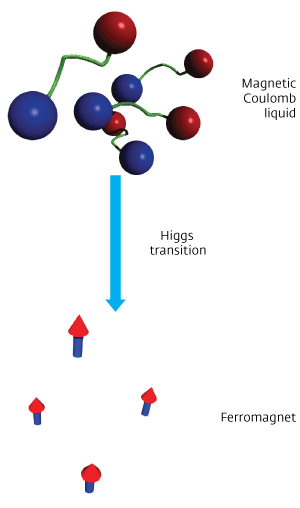Dec. 14, 2012 Research Highlight Physics / Astronomy
There’s more to Higgs than bosons
The observation of novel behavior in a magnetic material suggests a fresh approach to studying fundamental quantum phenomena
 Figure 1: An international research team has found clear evidence for a Higgs transition in a magnetic material, in which a so-called magnetic Coulomb liquid, consisting of magnetic monopoles, assumes ferromagnetic order upon cooling. Adapted from Ref. 1 © 2012 Nature Publishing Group
Figure 1: An international research team has found clear evidence for a Higgs transition in a magnetic material, in which a so-called magnetic Coulomb liquid, consisting of magnetic monopoles, assumes ferromagnetic order upon cooling. Adapted from Ref. 1 © 2012 Nature Publishing Group
The name Higgs has been the talk of the town this year, since the elusive ‘Higgs boson’—an elementary particle that, among other things, endows other particles with mass—was discovered in the CERN research facility. Now, an international research team including Shigeki Onoda of the RIKEN Advanced Science Institute, Wako, has provided strong evidence that the same basic mechanism—the so-called Higgs mechanism that endows particles with mass—is also at play in an entirely different system, namely a magnet1. Their finding establishes a solid-state material as a versatile platform for studying the Higgs mechanism and related phenomena and may lead to important technological advances in the field of spintronics.
The team of scientists from Japan, Taiwan, Germany and the United Kingdom has studied the material Yb2Ti2O7. This compound is of particular interest as it is a variant of a material known as ‘spin ice’, where the two poles of the magnetic subunits within the crystal become almost detached from each other (Fig. 1, top). Such magnetic ‘monopoles’ are unknown in conventional magnets—in a bar magnet, for instance, the attractive and repulsive ends can never exist separately. In materials like Yb2Ti2O7, however, magnetic monopoles can occur. Moreover, previous work has suggested that at temperatures very close to absolute zero, Yb2Ti2O7 undergoes a transition from the monopole state to a so-called ferromagnetic state (Fig. 1, bottom), which corresponds to the magnetic order found, for example, in iron.
The transition to the ferromagnetic state was possibly linked to the Higgs mechanism but without definite evidence. “There was a controversy over the earlier findings and the problem turned out to be related to the sample quality,” explains Onoda. “So we had to show more convincing evidence for the ferromagnetic order and emergent magnetic monopoles below and slightly above the transition temperature, respectively.” This evidence has come from a detailed neutron-scattering study, in which the researchers looked at the magnetic structure of Yb2Ti2O7. The new findings confirm the previous results, while also supporting the researchers’ theoretical picture and providing a key observation required as a minimum for the interpretation of the transition in terms of a Higgs transition.
These results suggest that Yb2Ti2O7 and related spin-ice systems can serve as a platform to explore fundamental aspects of quantum physics. They also provide important new insights into the behavior of magnetic monopoles, indicating a route to novel designs for spintronics devices.
References
- 1. Chang, L.-J., Onoda, S., Su, Y., Kao, Y.-J., Tsuei, K.-D., Yasui, Y., Kakurai, K. & Lees, M.R. Higgs transition from a magnetic Coulomb liquid to a ferromagnet in Yb2Ti2O7. Nature Communications 3, 992 (2012). doi: 10.1038/ncomms1989
